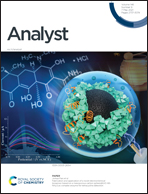A turn-on homodimer fluorescent probe based on homo-FRET for the sensing of biothiols in lysosome: a trial of a new turn-on strategy†
Abstract
Fluorescence resonance energy transfer (FRET) is often applied to construct fluorescent probes for acquiring high selectivity and sensitivity. According to the FRET theory, a homodimer composed of two identical fluorophores with a small Stokes shift has only weak fluorescence due to homo-FRET between fluorophores, and the fluorescence could be recovered after the destruction of the homodimer. In this study, we designed and synthesized a homodimer fluorescent probe, namely 1,3,5,7-tetramethyl-8-(4′-phenylthiophenol)-boron difluoride-dipyrrole methane dimer (D-TMSPB), based on this turn-on strategy. In D-TMSPB, the disulfide moiety was selected as the response moiety of biothiols, and BODIPY fluorophore was chosen as both donor and acceptor in FRET due to the ultra-small Stokes shifts and obvious overlap of its excitation/emission peak. D-TMSPB exhibited only weak fluorescence. After selective reaction with biothiols, FRET was destroyed and the derivative exhibited strong fluorescence at 514 nm with the limit of detection of about 0.15 μM for GSH. Notably, the derivative of biothiols shows remarkable fluorescence only in acidic conditions, which accords with the internal environment of lysosome. Thus, D-TMSPB was applied to image the biothiols of lysosome in living cells. The turn-on fluorescence of D-TMSPB indicated that homo-FRET is a practical strategy to design turn-on fluorescent probes, particularly for the sensing mechanism based on leaving groups.



 Please wait while we load your content...
Please wait while we load your content...